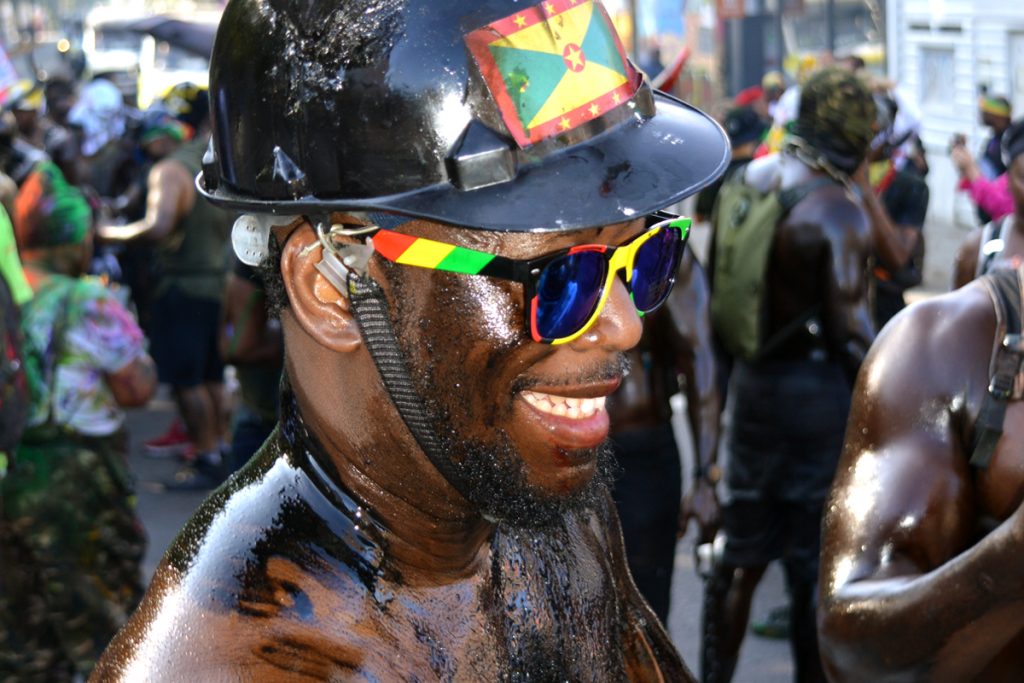Lurking in the shadows on the opposite side of the road, two policemen eyed me warily as I walked down Ladbroke Grove. I affected nonchalance, but anticipation gnawed at me. It was intensified by the knowledge that I was going in search of an illicit pleasure, a ritual now deemed unacceptable for Notting Hill’s corporate-friendly, ‘festivalised’ carnival.
“J’Ouvert cancelled” – the shocking news had spread with virus-like speed across the carnivalsphere. Devotees of mud, oil and chains puzzled over the cryptic message: “Cancelled due to no official bands able to participate this year”. What official bands? Who had the right to cancel what had never been “official” in the first place? And why weren’t the steel bands able to participate? Who, or what, was stopping them? Why was it so important to keep people away from an event that had no recorded history of ‘trouble’?
Rumours took wing – council takeover, police wanting to save the cost of a shift, a power struggle between Notting Hill Carnival’s organiser, NHCL/CVT, and the steelbands association, BAS? To date, those in the know have refused to comment. Careless talk costs reputations, after all.*
Away from the ivory towers of power, an underground movement began. Whispers, brief messages and hurried calls coalesced into a palpable sense of resistance. On that bright, chilly start to Carnival Sunday, I found a first sign of rebellion: a discreet criss-crossing of colours glistening on the grey pavement. Cautiously checking that I wasn’t being observed, I put a finger to the paint – it was still wet! I was on the trail…
Faint rhythms rippled their way through the still air. They came from under the motorway bridge by Ladbroke Grove station. Of course – where else would a revolution start? It’s here that the spirit of J’Ouvert has always resonated with greatest intensity, bouncing its irresistible beats off the concrete.
And so it was that I came across a small group of wild-eyed J’Ouvert cultists, sinister in masks and horns, dragging their chains, smeared in oil, adorned with vivid gashes of crimson and yellow paint. They danced with post-apocalyptic fervour amid the wreckage of paint tubes and drinks cans, devoid of inhibitions. Each body was a Jackson Pollock canvas of colour-clashing streaks, dribbles, smears and handprints. From the other side of the road, the bacchanalian scene was watched by an impassive gentleman, immaculate in black and white and smoking a pipe, as if gravely assessing the participants for a street-theatre grant application. A black labrador, speckled in green paint, danced with its owner.
The rebel revellers under the bridge were joined by a darkly glistening posse of jab-jabs, swelling the crowd to something over 120. Fears that a latter-day Captain Baker and his truncheon-wielding hordes would descend on the misbegotten throng proved groundless. Rather than police ‘black marias’, it was the van of Mr Whippy – perhaps attracted by the sight of so many chained bodies – that sought our custom.
As the sun rose higher in the sky, the partisans of paint and powder faded away into anonymity of the crowd, their aim achieved: a crucial part of carnival culture had been de-cancelled. No one can take away what does not belong to them.
But who was the mysterious beauty in black lace? To this conundrum your reporter has no answer!
* You have the chance to demand answers of RBKC, the Metropolitan Police and Carnival Village Trust at the Notting Hill Carnival residents’ meeting at The Tabernacle, Powis Square, on Thursday 5 September. It’s free and starts at 7pm.

